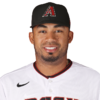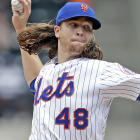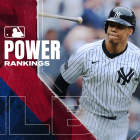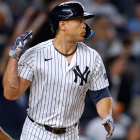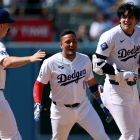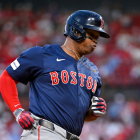With the second half underway, this is an appropriate time to focus on the important questions -- like which player is worth watching on each squad from now until season's end. "Worth watching" is a vague term, and we're embracing its broadness here. Some players are listed because they're vital to their team's short- and/or long-term success, others because they're fun to watch, and a few for other oddball reasons. Whatever the explanation, here are our picks, listed in order of the standings. (We tackled the American League yesterday.)
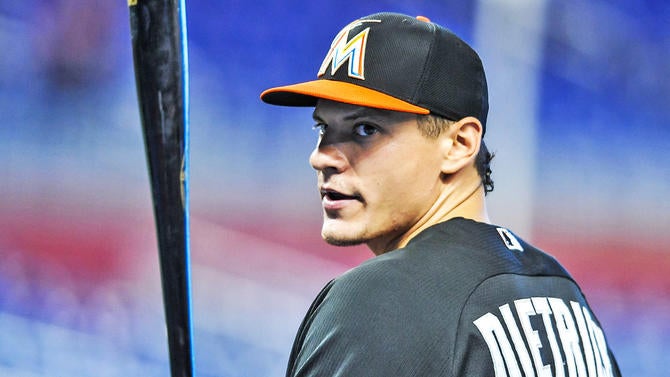
National League East
Second basemen aren't supposed to find another gear as they enter their 30s. Yet Daniel Murphy, now 31, is having some kind of banner season. He's already topped his previous career-high in home runs (by three in 160 fewer at-bats), and he's flirting with both a .350 average and a .400 on-base percentage. Pretty good. Barring a second-half collapse, Murphy is almost certainly going to garner MVP votes come this winter. To think, he didn't want to leave the Mets.
The go-to answers here are Giancarlo Stanton, Jose Fernandez, Christian Yelich, and/or Marcell Ozuna. We'll go off the board to acknowledge how important Derek Dietrich has been in keeping the Marlins in the race. Remember, the Marlins lost one of their top players in Dee Gordon, yet they haven't missed him nearly as much as expected because Dietrich has continued to hit at well-above-average levels. The questions about his glove and long-term defensive home remain -- not to mention his short-term defensive home when Gordon returns from suspension in late July -- but those are small beans. When a player hits this well, you find a spot for him in the lineup. We'll see what the Marlins figure out in the coming weeks, because Dietrich is playing too well to rot away on the bench.
Noah Syndergaard's continued emergence and Matt Harvey's season-ending surgery have left Jacob deGrom as the forgotten man in the Mets' rotation. Let's change that. While deGrom has missed time himself, he's also putting together a quality season. His strikeout-to-walk ratio is the second best in the Mets' rotation, and his 155 ERA+ would represent a new career best. Big whoop, you might think, considering everything else going on (and going wrong) with the Mets. Still, deGrom can control only what he can control, and he's doing a darn good job in that respect.
Aaron Nola would've made this list had it been formed in early June. He's on it now for a different reason. Back then, he had a 2.65 ERA and 70 more strikeouts to walks in 78 innings over his first 12 starts. Nola has since gone the other way, yielding 30 runs in 18 innings sprinkled across his last five appearances. That stretch has skewered his overall line and has robbed Phillies fans of a point of glee. So, what's next? Nola will probably figure things out and get back on track. That mustard seed of doubt, however, makes his situation worth following.
Similar to the Nola choice in a sense. The Braves' rebuild hinges on young arms living up to their potential, and Mike Foltynewicz's size and raw stuff places him among Atlanta's most intriguing arms. Alas, the debate about his long-term role remains lively. While Foltynewicz throws more than enough strikes to start, his substandard command causes him to be overly loose within the zone -- hence 11 home runs in 49 innings. The Braves have every reason to give him as many chances in the rotation as he can handle, with the hope that settles in as a mid-rotation type. For now, growing pains are inevitable.
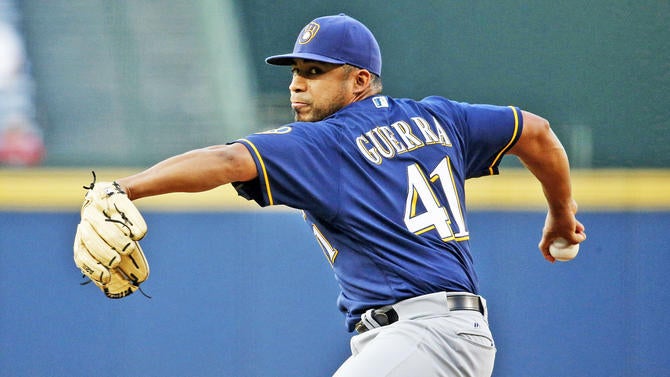
National League Central
Previously a trade-rumor staple, Javier Baez has calmed the water by making the most of his opportunities this season. Still, there's a lot to think about here as it pertains to his future. Baez has done a good job of slicing into his strikeout rate, but he seldom walks due to a super-aggressive approach. He hits the ball hard when his swing connects, yet his penchant for popping up limits his ability to hit for average. Baez has produced all the same -- and his overall talent is obvious -- but there's more room for volatility here than we'd like to think. His next five seasons are going to be fascinating.
It's hard to keep a low profile with a nickname like "Final Boss," yet Seung Hwan Oh has managed to do just that. He's been the Cardinals' best reliever all season long -- peep the 4.69 strikeout-to-walk ratio and 238 ERA+ -- and should probably be their full-time closer for the remainder of the year. The Cardinals moved to a closing committee after demoting Trevor Rosenthal, but Oh is the only one to log saves since Rosenthal's last shot in the ninth inning. Wherever Oh has pitched, he's continued to dominate behind his command and deception. He doesn't throw as hard as the typical late-inning stud and he's not going to intimidate anyone with his small stature, but he's been a highly effective reliever and a bright spot for a team that could use more of them.
The crazy-fast ascents of Mike Trout, Bryce Harper, and Manny Machado have spoiled us to the point where we sour quick on prospects who aren't day-one superstars. Gregory Polanco is a good example. He entered the season as a 24-year-old not far removed from being heralded as a top prospect. Yet because Polanco hadn't played exceptionally well over his first season-plus in the majors, we were beginning to wonder if he'd ever break out. Boy, don't we look silly now? Polanco has been exactly what those old scouting reports suggested he could become: a well-rounded hitter who adds value with his glove. He looks like a star-level performer, and the Pirates look awfully smart for extending him when they did.
One of the season's best stories. Junior Guerra went more than five years between signing a contract with a MLB team -- not just a big-league contract, any contract. He debuted with the White Sox late last year, but was cleared off their 40-man roster during the offseason. The Brewers claimed Guerra, and he's since become a surprisingly competent member of their rotation. Guerra credits his split-finger for saving his career, and while you might be skeptical of his long-term viability, consider this: The mere fact that he's even a topic of conversation is within itself that crazy stuff always happens in baseball.
You can make the case that one of Cincinnati's young pitchers should be here instead, but Billy Hamilton combines the fun-to-watch aspect with the long-term-ramifications talking point. He's a brilliant defender with a knack for making impossible grabs. He's also a terrible hitter who lacks an offensive skill beyond stealing bases. Inevitably, one of two outcomes will occur. Either Hamilton is going to lose too much of his athleticism (through injury and aging) to make up for his weak bat, or he's going to figure out how to hit just enough to become a star. The former seems more likely right now, but it's a development worth paying attention to anyway.

National League West
A straightforward pick. Madison Bumgarner is worth paying attention to whenever he's on the mound, and it just so happens he's having the finest regular season of his career. In addition to recording 16 quality starts in 20 tries (his current single-season best is 23) and three complete games (his best is four), he's also averaging as many innings per start (6.8) as ever before. Bumgarner will turn 27 on August 1. That's a scary thought. He might be getting better. That's an even scarier thought.
Acquired as part of the Joel Peralta trade -- yes, there was a Joel Peralta trade -- Adam Liberatore profiled as an up-and-down arm who could latch on someday as a second lefty. Predictably, he now leads baseball in ERA+ (646) thanks to a 0.61 ERA that's just a tick higher than Fernando Rodney's record mark. Liberatore doesn't work full innings as often as Rodney did, so it's not a one-to-one comparison. But look, the guy hasn't allowed a run since May 18 nor a hit since June 21. He deserves some attention.
Tyler Chatwood has had an odd career in Colorado. He found success in 2013, then missed most of 2014 and all of 2015 while recovering from Tommy John surgery. In his return, he's picked up where he left off, generating copious amounts of grounders while posting shaky strikeout-to-walk ratios. Chatwood doesn't miss bats, doesn't possess elite control, and doesn't use more than three pitches, including two fastballs, most of the time ... yet he gets enough double-play balls to maintain a shiny ERA. It's an unusual formula for success, and not one most of us necessarily embrace -- who wants to be the new Aaron Cook? -- but life is about different experiences. Sometimes that means growing a beard or singing "Smooth" to the neighbor's chickens, and sometimes that means watching Chatwood pitch.
When the Padres traded Chase Headley to the Yankees for Yangervis Solarte and Rafael De Paula, many of us thought the package felt light. Solarte has since outhit Headley, batting .274/.334/.427 as compared to .259/.335/.377 -- and those numbers aren't park-adjusted. Add in how Solarte is cheaper and younger than Headley, and you'd have to say the Padres got the better end of the deal. Now you just have to wonder whether the Friars will make Solarte available at the deadline. After all, switch-hitting third basemen with at least league-average sticks don't grow on trees -- even if the Padres' recent history suggests otherwise.
You can argue for Jake Lamb here, but we're giving the nod to Paul Goldschmidt for the same reasons we gave the nod to Mike Trout: he's too good to miss. Goldschmidt is flirting with a .300/.400/.500 line for the third time in four seasons (the exception being 2014, when he missed out on that accomplishment by four points of on-base percentage), and has already swiped double-digit bags for the fourth time. The only blemish here is one Goldschmidt can't control: the D-Backs have won more than 81 games once during his career, and that came during his rookie season. Hopefully things get turned around in the desert soon, because Goldschmidt's talent deserves a bigger stage.




















